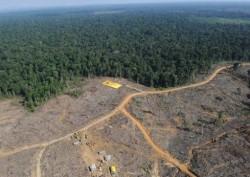
To address climate change, the United Nations Framework Convention on Climate Change (UNFCCC)was adopted in 1992. This convention aims to stabilize concentrations of greenhouse gases in the atmosphere at a level that allows the prevention of the dangerous effects of climate change on the planet.
 The Kyoto Protocol (KP), adopted within the UNFCCCin 1997, constitutes the legal commitment of developed countries to reduce emissions of greenhouse gases. The emissions can be reduced from six sectors;between them the Land Use, Land Use Change and Forestry (LULUCF) sector. The KP is the first important step for global consensus on reducing emissions, and the first step of global environmental legislation. The KP includes quantitative emissions reduction targets, in relation to the reference year which was set to be 1990.
The Kyoto Protocol (KP), adopted within the UNFCCCin 1997, constitutes the legal commitment of developed countries to reduce emissions of greenhouse gases. The emissions can be reduced from six sectors;between them the Land Use, Land Use Change and Forestry (LULUCF) sector. The KP is the first important step for global consensus on reducing emissions, and the first step of global environmental legislation. The KP includes quantitative emissions reduction targets, in relation to the reference year which was set to be 1990.
 Greece is between the countries that have committed to limit the increase in emissions by 25%. With regards to LULUCF, Greece decided to account greenhouse gas emissions and removals in the sector of Forest Management. The competent authority for both implementing the provisions of KP, and compiling therequired National Inventory Report (NIR) is the Ministry of Environment, Energy and Climate Change, under the law n. 3017/2002.
Greece is between the countries that have committed to limit the increase in emissions by 25%. With regards to LULUCF, Greece decided to account greenhouse gas emissions and removals in the sector of Forest Management. The competent authority for both implementing the provisions of KP, and compiling therequired National Inventory Report (NIR) is the Ministry of Environment, Energy and Climate Change, under the law n. 3017/2002.
Therefore, Greece is obliged to submit reports of national inventories of emissions and removals of greenhouse gases in an annual basis. This annual national report should include assessments of the areas where LULUCF activities take place, estimates of emissions and removals of greenhouse gases from such areas,as well as the uncertainty of these estimates.
Since 2005 the reports are compiled on the basis of the -especially demanding in data entry - Best Practice Guide for LULUCF (GPD-LULUCF) which was recommended by the Intergovernmental Panel on Climate Change (IPCC) in 2003. Greece followed the GPD-LULUCF in the NIR of 2005, however the methodologycurrently used presents serious shortcomingsin monitoring both land use in the country, and the emission and absorption factors of greenhouse gases.
For further information for the obligations of Greece under the KP please refer to Report 2.α

